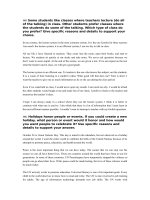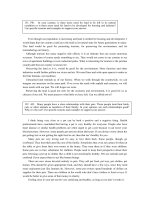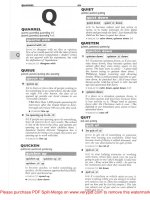economic english 9 ppt
Bạn đang xem bản rút gọn của tài liệu. Xem và tải ngay bản đầy đủ của tài liệu tại đây (138.95 KB, 6 trang )
CONTACT FORCE
Contact forces are forces that exist as a result of an inter-
action between objects that are physically in contact with
one another. They include frictional forces, tensional
forces, and normal forces.
The friction force opposes the motion of an object
across a surface. For example, if a glass moves across the
surface of the dinner table, there exists a friction force in
the direction opposite to the motion of the glass. Friction
is the result of attractive intermolecular forces between
the molecules of the surface of the glass and the surface
of the table. Friction depends on the nature of the two
surfaces. For example, there would be less friction
between the table and the glass if the table was moistened
or lubricated with water. The glass would glide across the
table more easily. Friction also depends on the degree to
which the glass and the table are pressed together. Air
resistance is a type of frictional force.
Tension is the force that is transmitted through a rope
or wire when it is pulled tight by forces acting at each
end. The tensional force is directed along the rope or
wire and pulls on the objects on either end of the wire.
The normal force is exerted on an object in contact
with another stable object. For example, the dinner table
exerts an upward force on a glass at rest on the surface of
the table.
NUCLEAR FORCE
Nuclear forces are very strong forces that hold the
nucleus of an atom together. If nuclei of different atoms
come close enough together, they can interact with one
another and reactions between the nuclei can occur.
Forms of Energy
Energy is defined as the ability to do work. We have
already stated that energy can’t be created or destroyed;
it can only change form. Forms of energy include poten-
tial energy and kinetic energy.
Potential energy is stored energy. Kinetic energy is the
energy associated with motion. Look at the following
illustration. As the pendulum swings, the energy is con-
verted from potential to kinetic, and back to potential.
When the hanging weight is at one of the high points, the
gravitational potential energy is at the maximum, and
kinetic energy is at the minimum. At the low point, the
kinetic energy is maximized, and gravitational potential
energy is minimized.
The change of potential energy into kinetic energy, and
kinetic energy into potential energy, in a pendulum
Examples of potential energy include nuclear energy
and chemical energy—energy is stored in the bonds that
hold atoms and molecules together. Heat, hydrodynamic
energy, and electromagnetic waves are examples of
kinetic energy—energy associated with the movement of
molecules, water, and electrons or photons (increments
of light).
Interactions of Energy
and Matter
Energy in all its forms can interact with matter. For
example, when heat energy interacts with molecules of
water, it makes them move faster and boil. Waves—
including sound and seismic waves, waves on water, and
light waves—have energy and can transfer that energy
when they interact with matter. Consider what happens
if you are standing by the ocean and a big wave rolls in.
Sometimes, the energy carried by the wave is large
enough to knock you down.
Waves
Energy is also carried by electromagnetic waves or light
waves. The energy of electromagnetic waves is related to
their wavelengths. Electromagnetic waves include radio
waves (the longest wavelength), microwaves, infrared
radiation (radiant heat), visible light, ultraviolet radia-
tion, X-rays, and gamma rays. The wavelength depends
on the amount of energy the wave is carrying. Shorter
wavelengths carry more energy.
When a wave hits a smooth surface, such as a mirror,
it is reflected. Sound waves are reflected as echoes. Mat-
ter can also refract or bend waves. This is what happens
when a ray of light traveling through air hits a water sur-
face. A part of the wave is reflected, and a part is refracted
into the water.
Maximum
Potential
Energy
Maximum
Potential
Energy
Maximum Kinetic
Energy
– PHYSICAL SCIENCE–
230
Each kind of atom or molecule can gain or lose energy
only in particular discrete amounts. When an atom gains
energy, light at the wavelength associated with that
energy is absorbed. When an atom loses energy, light at
the wavelength associated with that energy is emitted.
These wavelengths can be used to identify elements.
Nuclear Reactions
In a nuclear reaction, energy can be converted to matter
and matter can be converted to energy. In such processes,
energy and matter are conserved, according to Einstein’s
formula E = mc
2
,where E is the energy, m is the mass
(matter), and c is the speed of light. A nuclear reaction is
different from a chemical reaction because in a nuclear
reaction, the particles in nuclei (protons and neutrons)
interact, whereas in a chemical reaction, electrons are lost
or gained by an atom. Two types of nuclear reactions are
fusion and fission.
Fusion is a nuclear process in which two light nuclei
combine to form one heavier nucleus. A fusion reaction
releases an amount of energy more than a million times
greater than the energy released in a typical chemical
reaction. This gain in energy is accompanied by a loss of
mass. The sum of the masses of the two light nuclei is
lower than the mass of the heavier nucleus produced.
Nuclear fusion reactions are responsible for the energy
output of the sun.
Fission is a nuclear process in which a heavy nucleus
splits into two lighter nuclei. Fission reaction was used in
the first atomic bomb and is still used in nuclear power
plants. Fission, like fusion, liberates a great amount of
energy. The price for this energy is a loss in mass. A heavy
nucleus that splits is heavier than the sum of the masses
of the lighter nuclei that result.
Key Concepts
This chapter gave you a crash course in the
basics of physical science. Here are the most
important concepts to remember:
➧ All matter is composed of tiny particles
called atoms.
➧ Atoms combine with other atoms to form
molecules.
➧ In a chemical reaction, atoms in molecules
rearrange to form other molecules.
➧ The three common states of matter are
solid, liquid, and gas.
➧ The disorder in the universe is always
increasing.
➧ Mass and energy can’t be created or
destroyed.
➧ Energy can change form and can be trans-
ferred in interactions with matter.
– PHYSICAL SCIENCE–
231
IFE SCIENCE EXPLORES the nature of living things, from the smallest building blocks of life to the
larger principles that unify all living beings. Fundamental questions of life science include:
■
What constitutes life?
■
What are its building blocks and requirements?
■
How are the characteristics of life passed on from generation to generation?
■
How did life and different forms of life evolve?
■
How do organisms depend on their environment and on one another?
■
What kinds of behavior are common to living organisms?
Before Anthony van Leeuwenhoek looked through his homemade microscope more than 300 years ago, people
didn’t know that there were cells in our bodies or that there were microorganisms. Another common miscon-
ception was that fleas, ants, and other pests came from dust or wheat. Leeuwenhoek saw blood cells in blood,
found microorganisms in ponds, and showed that pests come from larvae that hatch from eggs laid by adult pests.
However, it took more than 200 years for Leeuwenhoek’s observations to gain wide acceptance and find appli-
cation in medicine.
CHAPTER
Life Science
LIFE SCIENCE questions on the GED cover the topics studied in
high school biology classes. In this chapter, you will review the basics
of biology and learn the answers to some of the key questions scien-
tists ask about the nature of life and living beings.
24
233
The Cell
Today, we know that a cell is the building block of life.
Every living organism is composed of one or more cells.
All cells come from other cells. Cells are alive. If blood
cells, for example, are removed from the body, given the
right conditions, they can continue to live independently
of the body. They are made up of organized parts, per-
form chemical reactions, obtain energy from their sur-
roundings, respond to their environments, change over
time, reproduce, and share an evolutionary history.
All cells contain a membrane, cytoplasm, and genetic
material. More complex cells also contain cell organelles.
Here is a description of cell components and the func-
tions they serve. Also, refer to the figures on the next page.
■
The cell wall is made of cellulose, which sur-
rounds, protects, and supports plant cells. Animal
cells do not have a cell wall.
■
The plasma membrane is the outer membrane of
the cell. It carefully regulates the transport of
materials in and out of the cell and defines the
cell’s boundaries. Membranes have selective per-
meability—meaning that they allow the passage
of certain molecules, but not others. A membrane
is like a border crossing. Molecules need the
molecular equivalent of a valid passport and a
visa to get through.
■
The nucleus is a spherical structure, often found
near the center of a cell. It is surrounded by a
nuclear membrane and it contains genetic infor-
mation inscribed along one or more molecules of
DNA. The DNA acts as a library of information
and a set of instructions for making new cells and
cell components. To reproduce, every cell must be
able to copy its genes to future generations. This
is done by exact duplication of the DNA.
■
Cytoplasm is a fluid found within the cell mem-
brane, but outside the nucleus.
■
Ribosomes are the sites of protein synthesis essen-
tial in cell maintenance and cell reproduction.
■
Mitochondria are the powerhouses of the cell.
They are the site of cellular respiration (break-
down of chemical bonds to obtain energy) and
production of ATP, a molecule that provides
energy for many essential processes in all organ-
isms. Cells that use a lot of energy, such as the
cells of a human heart, have a large number of
mitochondria. Mitochondria are unusual because
unlike other cell organelles, they contain their
own DNA and make some of their own proteins.
■
The endoplastic reticulum is a series of intercon-
necting membranes associated with the storage,
synthesis, and transport of proteins and other
materials within the cell.
■
The Golgi complex is a series of small sacs that
synthesizes, packages, and secretes cellular prod-
ucts to the plasma membrane. Its function is
directing the transport of material within the cell
and exporting material out of the cell.
■
Lysosomes contain enzymes that help with intra-
cellular digestion. Lysosomes have a large pres-
ence in cells that actively engage in
phagocytosis—the process by which cells con-
sume large particles of food. White blood cells
that often engulf and digest bacteria and cellular
debris are abundant in lysosomes.
■
Vacuoles are found mainly in plants. They partic-
ipate in digestion and the maintenance of water
balance in the cell.
■
Centrioles are cylindrical structures found in the
cytoplasm of animal cells. They participate in cell
division.
■
Chloroplasts exist in the cells of plant leaves and
in algae. They contain the green pigment chloro-
phyll and are the site of photosynthesis—the
process of using sunlight to make high energy
sugar molecules. Ultimately, the food supply of
most organisms depends on photosynthesis car-
ried out by plants in the chloroplasts.
■
The nucleolus is located inside the nucleus. It is
involved in the synthesis of ribosomes, which
manufacture proteins.
In a multicellular organism, individual cells
specialize in different tasks. For example, red
blood cells carry oxygen, white blood cells fight
pathogens, and cells in plant leaves collect the
energy from sunlight. This cellular organization
enables an organism to lose and replace individual
cells, and outlive the cells that it is composed of.
For example, you can lose dead skin cells and give
blood and still go on living. This differentiation or
division of labor in multicellular organisms is
accomplished by expression of different genes.
– LIFE SCIENCE–
234
Molecular Basis of Heredity
What an organism looks like and how it functions is
determined largely by its genetic material. The basic
principles of heredity were developed by Gregor Mendel,
who experimented with pea plants in the 19th century.
He mathematically analyzed the inherited traits (such as
color and size) of a large number of plants over many
generations. The units of heredity are genes carried on
chromosomes. Genetics can explain why children look
like their parents, and why they are, at the same time, not
identical to the parents.
Phenotype and Genotype
The collection of physical and behavioral characteristics
of an organism is called a phenotype. For example, your
eye color, foot size, and ear shape are components of
your phenotype. The genetic makeup of a cell or organ-
ism is called the genotype. The genotype is like a cook-
book for protein synthesis and use. Phenotype (what an
organism looks like or how it acts) is determined by the
genotype (its genes) and its environment. By environ-
ment, we don’t mean the Earth, but the environment
surrounding the cell or organism. For example, hor-
mones in the mother’s body can influence the gene
expression.
Reproduction
Asexual reproduction on the cellular level is called mito-
sis. It requires only one parent cell, which, after exactly
multiplying its genetic material, splits in two. The result-
ing cells are genetically identical to each other and are
clones of the original cell before it split.
Sexual reproduction requires two parents. Most cells
in an organism that reproduces sexually have two copies
of each chromosome, called homologous pairs—one
from each parent. These cells reproduce through mitosis.
Gamete cells (sperm and egg cells) are exceptions. They
carry only one copy of each chromosome, so that there
are only half as many chromosomes as in the other cells.
For example, human cells normally contain 46 chromo-
somes, but human sperm and egg cells have 23 chro-
mosomes. At fertilization, male and female gametes
(sperm and egg) come together to form a zygote, and the
number of chromosomes is restored by this union. The
genetic information of a zygote is a mixture of genetic
information from both parents. Gamete cells are manu-
factured through a process called meiosis, whereby a cell
multiples its genetic material once, but divides twice,
producing four new cells, each contains half the number
of chromosomes present in the original cell before divi-
sion. In humans, gametes are produced in testes and
ovaries. Meiosis causes genetic diversity within a species
by generating combinations of genes different from
those present in the parents.
– LIFE SCIENCE–
235
2
2
2
2
2
2
2
2
2
2
2
Cytoplasm
Endoplasmic
reticulum
Plasma
membrane
Nucleolus
Nucleus
Vacuole
Cell wall
Ribosomes
Mitochondria
Centriole
Chloroplast
Lysosome
Animal Cell
Plant Cell
Golgi
complex









